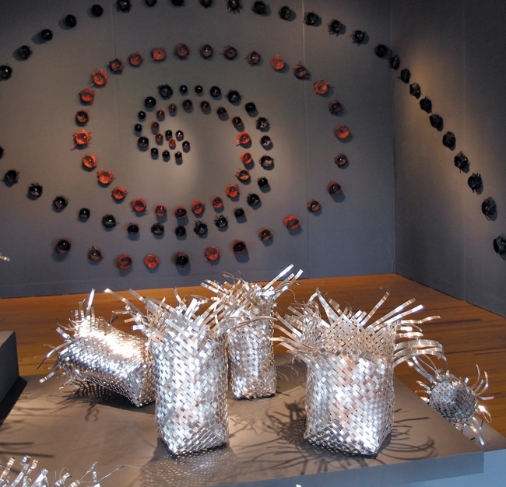Linking Ancient and Modern
Like a giant hive comprised of myriad honied chambers of knowledge, Bishop Museum is an invaluable storehouse of information on ancient Hawaiian culture and traditions. Add an exhibit by Native Hawaiian artist Ivy Hali’imaile “Maile” Andrade, and the hive buzzes with renewed life.
Andrade’s exhibit, ‘Ike Loloa: A long Insightful Journey, launched May 17 after she was chosen as the recipient of the eighth annual Maoli Arts Month (MAMo) Award.
art_2
“For the past eight years, Bishop Museum has partnered with PA’I Foundation (whose mission is to preserve and perpetuate Hawaiian culture),” says the museum’s community affairs director and MAMo co-chair Noelle Kahanu. “We provide space to showcase the work of the MAMo Awards, which recognizes master visual artists.”
Enter the room and native themes instantly are recognizable in the form of woven baskets, carved totem rocks and tattoo imagery. Yet, there’s something altogether contemporary about the works. Baskets are woven from metal, and masks bearing ethnic symbols also bear written English phrases and are made of glass.
“Maile is phenomenal, just in terms of the variety of media that she works with lauhala, ceramics, glass, aluminum, embroidered gloves, silk, velvet, print,” notes Kahanu. “It’s just crazy how diverse her work is, but there’s a common aesthetic. You look at the show and you don’t feel like it’s from all different artists. You feel that it’s the work of one artist.
“One of the ways Maile looks at Native Hawaiian visual art is to study the work of her ancestors, so she has done a lot of research on the kapa collections at Bishop Museum, Peabody Essex Museum and elsewhere, and what that reveals in terms of the Native Hawaiian world view. The program she established at the Center for Hawaiian Studies (at UH Manoa) gets to that point: What is that visual aesthetic and what does it reveal about the Hawaiian mind-set? That’s what underlays a lot of her work; that is the meaning, the depth behind each of her pieces.”
Woven baskets spaced in waves across the wall reflect a seemingly simple and ordered visual representation of the Kumulipo, or creation chant. It’s a vision of a swirling, developing cosmos, but an active voice speaks through each of Andrade’s tableaus, belying their immediate face value. Sitting beside the evenly spaced basket design is a chaos of crumpled aluminum baskets. The work is titled, “Kahuli: To overturn, overthrow, upset, to change, alter.” The display touches on the movement from harmony to entropy, from connection with the ‘aina to disruption, on ancient truths being eclipsed by imbalance.
Other offerings feature glass masks bearing significant meaning.
In “He Aha Kou Mana’o? What are the thoughts and foundations that make us who we are today?” a series of faces look out from the wall.
“Each of the faces is different,” says Kahanu. “They were installed at Maile’s honi height, like when you greet somebody. There are words imbedded and layers and layers of information in each piece.”
Nearby, four glass masks form “Enter-generational.”
“This piece is about the women ancestors in Maile’s life,” says Kahanu. “She took multiple images pictures of different people and she layered their faces on top of each other, and arrows in the middle form a backbone.” The images focus on who “we” – Native Hawaiians, Andrade herself, the viewer – are, based on the women we come from.
The MAMo Award was born out of a dearth of recognition for master visual artists in the community. Hawaiian music and hula have multiple venues and a longstanding tradition of community recognition, but until MAMo, no particular regard has been given to the visual arts, Kahanu points out.
“What’s exciting about Maile is she’s always continuing to grow,” says Kahanu. “(A schooled ceramics and fiber artist), she just picked up glass recently and she does jewelry work. Who can predict a year from now what she’ll be doing? That’s what the inspiration for the title is: ‘Ike Loloa. ‘Ike is insight, loloa is a long stretch. It’s that ability for her to keep going down this path of visual exploration, and we get to watch her creations along the way. Also, as a textile artist, she’s very into texture and layers, not only of material, but of meaning.”
the TICKET stub
‘IKE LOLOA EXHIBIT
When: Daily, through Oct. 7 (closed Tuesdays)
Where: Bishop Museum (1525 Bernice St.)
Cost: $8.95-$19.95
More Info: 847-3511, bishopmuseum.org






